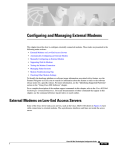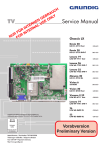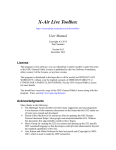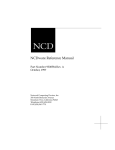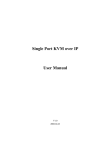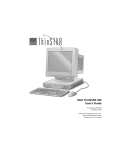Download Cisco Systems DC-157 User's Manual
Transcript
Modem Signal and Line States This chapter describes modem states in the following section: • Signal and Line State Diagrams To identify the hardware platform or software image information associated with a feature, use the Feature Navigator on Cisco.com to search for information about the feature or refer to the software release notes for a specific release. For more information, see the “Identifying Supported Platforms” section in the “Using Cisco IOS Software” chapter. For a complete description of the modem support commands in this chapter, refer to the Cisco IOS Modem Command Reference. To locate documentation of other commands that appear in this chapter, use the command reference master index or search online. Signal and Line State Diagrams The following signal and line state diagrams accompany some of the tasks in the following sections to illustrate how the modem control works: • Configuring Automatic Dialing • Automatically Answering a Modem • Supporting Dial-In and Dial-Out Connections • Configuring a Line Timeout Interval • Closing Modem Connections • Configuring a Line to Disconnect Automatically • Supporting Reverse Modem Connections and Preventing Incoming Calls Cisco IOS Dial Technologies Configuration Guide DC-157 Modem Signal and Line States Signal and Line State Diagrams The diagrams show two processes: • The “create daemon” process creates a tty daemon that handles the incoming network connection. • The “create EXEC” process creates the process that interprets user commands. (See Figure 25 through Figure 29.) In the diagrams, the current signal state and the signal the line is watching are listed inside each box. The state of the line (as displayed by the show line EXEC command) is listed next to the box. Events that change that state appear in italics along the event path, and actions that the software performs are described within ovals. Figure 25 illustrates line states when no modem control is set. The DTR output is always high, and CTS and RING are completely ignored. The Cisco IOS software starts an EXEC session when the user types the activation character. Incoming TCP connections occur instantly if the line is not in use and can be closed only by the remote host. Figure 25 EXEC and Daemon Creation on a Line with No Modem Control Ready DTR high Network connection closed Exit Incoming network connection User-typed activation character Create Ready and active daemon DTR high Create EXEC Cisco IOS Dial Technologies Configuration Guide DC-158 Ready and active Ringing S1201a DTR high Modem Signal and Line States Signal and Line State Diagrams Configuring Automatic Dialing With the dialup capability, you can set a modem to dial the phone number of a remote router automatically. This feature offers cost savings because phone line connections are made only when they are needed—you pay for using the phone line only when there is data to be received or sent. To configure a line for automatic dialing, use the following command in line configuration mode: Command Purpose Router(config-line)# modem dtr-active Configures a line to initiate automatic dialing. Using the modem dtr-active command causes a line to raise DTR signal only when there is an outgoing connection (such as reverse Telnet, NetWare Asynchronous Support Interface (NASI), or DDR), rather than leave DTR raised all the time. When raised, DTR potentially tells the modem that the router is ready to accept a call. Automatically Answering a Modem You can configure a line to answer a modem automatically. You also can configure the modem to answer the telephone on its own (as long as DTR is high), drop connections when DTR is low, and use its Carrier Detect (CD) signal to accurately reflect the presence of carrier. (Configuring the modem is a modem-dependent process.) First, wire the modem CD signal (generally pin-8) to the router RING input (pin-22), then use the following command in line configuration mode: Command Purpose Router(config-line)# modem dialin Configures a line to automatically answer a modem. You can turn on modem hardware flow control independently to respond to the status of router CTS input. Wire CTS to whatever signal the modem uses for hardware flow control. If the modem expects to control hardware flow in both directions, you might also need to wire modem flow control input to some other signal that the router always has high, such as the DTR signal. Figure 26 illustrates the modem dialin process with a high-speed dialup modem. When the Cisco IOS software detects a signal on the RING input of an idle line, it starts an EXEC or autobaud process on that line. If the RING signal disappears on an active line, the Cisco IOS software closes any open network connections and terminates the EXEC facility. If the user exits the EXEC or the software terminates because of no user input, the line makes the modem hang up by lowering the DTR signal for 5 seconds. After 5 seconds, the modem is ready to accept another call. Cisco IOS Dial Technologies Configuration Guide DC-159 Modem Signal and Line States Signal and Line State Diagrams Figure 26 EXEC Creation on a Line Configured for a High-Speed Modem Idle state DTR low, watching CTS Ring transition Raise DTR Lower DTR Answer timeout Hang up DTR high, watching CTS DTR low Lower DTR close connection Ringing CTS raised Create EXEC CTS lowered or exit Ready and active S1001a DTR high Supporting Dial-In and Dial-Out Connections To configure a line for both incoming and outgoing calls, use the following command in line configuration mode: Command Purpose Router(config-line)# modem inout Configures a line for both incoming and outgoing calls. Figure 27 illustrates the modem inout command. If the line is activated by raising the data set ready (DSR) signal, it functions exactly as a line configured with the modem dialin line configuration command described in the section “Automatically Answering a Modem” earlier in this chapter. If the line is activated by an incoming TCP connection, the line functions similarly to lines not used with modems. Cisco IOS Dial Technologies Configuration Guide DC-160 Modem Signal and Line States Signal and Line State Diagrams Figure 27 EXEC and Daemon Creation for Incoming and Outgoing Calls Idle state DTR high, watching CTS CTS raised Close connection, DTR low for 5 seconds CTS lowered DTR going low User-typed activation character Ready and active DTR high, watching CTS Incoming network connection Create EXEC DTR high, watching CTS Create daemon DTR high, watching CTS CTS lowered or exit Note Ready Ready and active CTS lowered or network connection closed S1004a Hang up If your system incorporates dial-out modems, consider using access lists to prevent unauthorized use. Configuring a Line Timeout Interval To change the interval that the Cisco IOS software waits for the CTS signal after raising the DTR signal in response to the DSR (the default is 15 seconds), use the following command in line configuration mode. The timeout applies to the modem callin command only. Command Purpose Router(config-line)# modem answer-timeout seconds Configures modem line timing. Note The DSR signal is called RING on older ASM-style chassis. Cisco IOS Dial Technologies Configuration Guide DC-161 Modem Signal and Line States Signal and Line State Diagrams Closing Modem Connections Note The modem cts-required command was replaced by the modem printer command in Cisco IOS Release 12.2. To configure a line to close connections from a user’s terminal when the terminal is turned off and to prevent inbound connections to devices that are out of service, use the following command in line configuration mode: Command Purpose Router(config-line)# modem cts-required Configures a line to close connections. Figure 28 illustrates the modem cts-required command operating in the context of a continuous CTS signal. This form of modem control requires that the CTS signal be high for the entire session. If CTS is not high, the user input is ignored and incoming connections are refused (or sent to the next line in a rotary group). Figure 28 EXEC and Daemon Creation on a Line Configured for Continuous CTS Idle state DTR high, watching CTS CTS raised Close connection, DTR low for 5 seconds CTS lowered DTR going low User-typed activation character Ready and active Create EXEC DTR high, watching CTS CTS lowered or exit Cisco IOS Dial Technologies Configuration Guide DC-162 DTR high, watching CTS Ready Incoming network connection Create daemon DTR high, watching CTS Ready and active CTS lowered or network connection closed S1004a Hang up Modem Signal and Line States Signal and Line State Diagrams Configuring a Line to Disconnect Automatically To configure automatic line disconnect, use the following command in line configuration mode: Command Purpose Router(config-line)# autohangup Configures automatic line disconnect. The autohangup command causes the EXEC facility to issue the exit command when the last connection closes. This feature is useful for UNIX-to-UNIX copy program (UUCP) applications because UUCP scripts cannot issue a command to hang up the telephone. This feature is not used often. Supporting Reverse Modem Connections and Preventing Incoming Calls In addition to initiating connections, the Cisco IOS software can receive incoming connections. This capability allows you to attach serial and parallel printers, modems, and other shared peripherals to the router or access server and drive them remotely from other modem-connected systems. The Cisco IOS software supports reverse TCP, XRemote, and local-area transport (LAT) connections. The specific TCP port or socket to which you attach the device determines the type of service that the Cisco IOS software provides on a line. When you attach the serial lines of a computer system or a data terminal switch to the serial lines of the access server, the access server can act as a network front-end device for a host that does not support the TCP/IP protocols. This arrangement is sometimes called front-ending or reverse connection mode. The Cisco IOS software supports ports connected to computers that are connected to modems. To configure the Cisco IOS software to function somewhat like a modem, use the following command in line configuration mode. This command also prevents incoming calls. Command Purpose Router(config-line)# modem callout Configures a line for reverse connections and prevents incoming calls. Figure 29 illustrates the modem callout process. When the Cisco IOS software receives an incoming connection, it raises the DTR signal and waits to see if the CTS signal is raised to indicate that the host has noticed the router DTR signal. If the host does not respond within the interval set by the modem answer-timeout line configuration command, the software lowers the DTR signal and drops the connection. Cisco IOS Dial Technologies Configuration Guide DC-163 Modem Signal and Line States Signal and Line State Diagrams Figure 29 Daemon Creation on a Line Configured for Modem Dial-Out Idle state DTR low Incoming network connection Raise DTR Lower DTR Answer timeout DTR high, watching CTS Ringing Close connection CTS raised Lower DTR Network connection closed or CTS lowered Create daemon watching CTS Ready and active Cisco IOS Dial Technologies Configuration Guide DC-164 S1930 DTR high,








